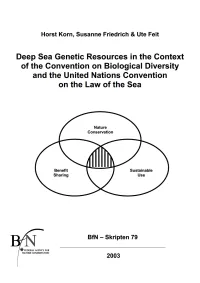BfN Schriften 79 - Deep Sea Genetic Resources in the Context of the Convention on Biological Diversity and the United Nations Convention on the Law of the Sea
This text therefore will focus on these deep-sea habitats. But some suggestions may be valuable for other habitats as well.


Description
Unusual symbioses between invertebrates and chemolithautotrophic bacteria are producing concentrations
of biomass at hydrothermal vent sites that is similar to the most productive ecosystems on Earth. The
existence of chemoautotrophic and hyperthermophilic microbes in the hydrothermal waters has promoted
new theories of the origin of life on Earth. The unbelievable high number of over 500 new animal species
and the high endemism rate at vents has provided a great impetus to marine conservation measures
on the high seas. Biodiversity as a term which can be used on all levels of biological organisation, ranging
from a measure of the genetic variability of one population to the diversity of major ecosystem-types . In
recent years long-term and large-scale researches of the deep-sea environment has begun and the commercial
sector is now able to operate in water depths of at least 2,000 m. So far exploitation is concentrated
in areas within national jurisdiction.